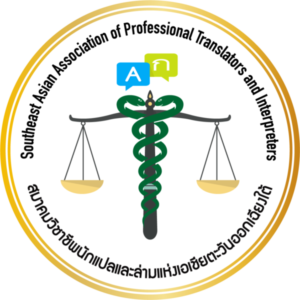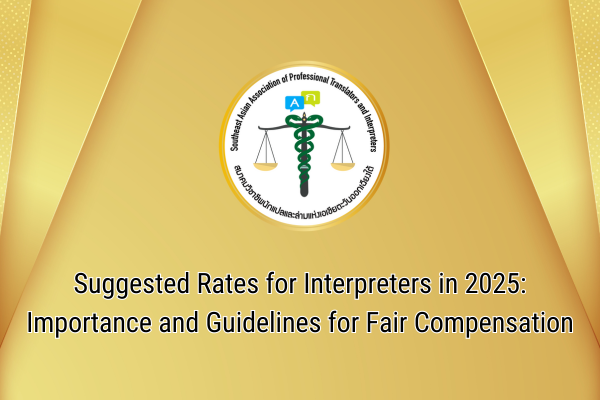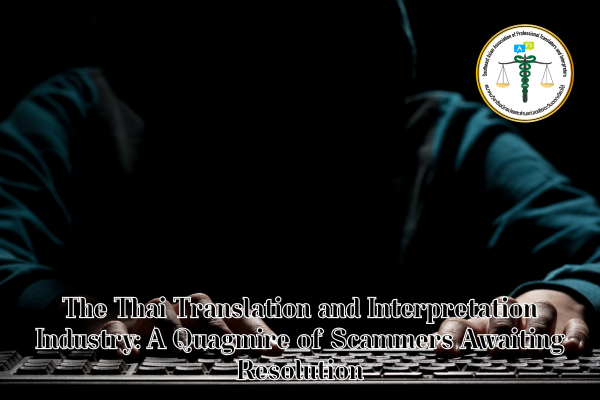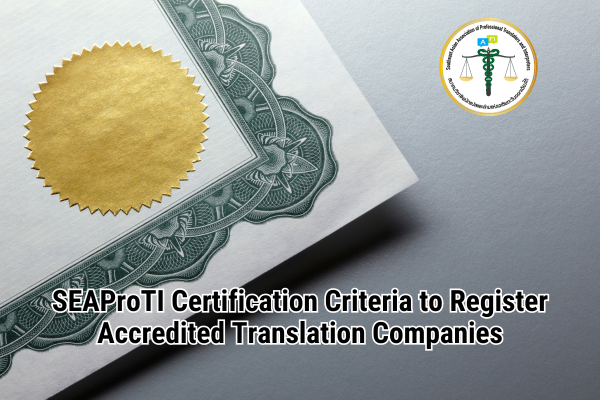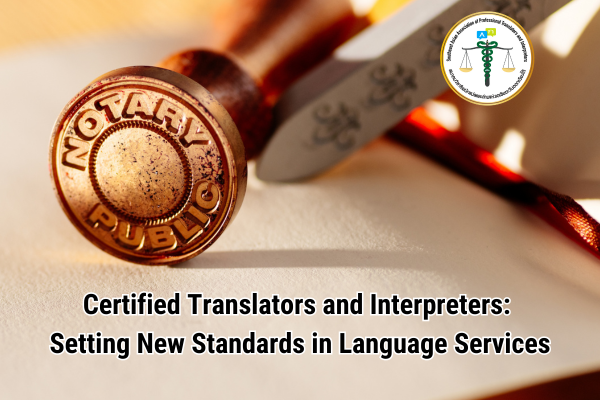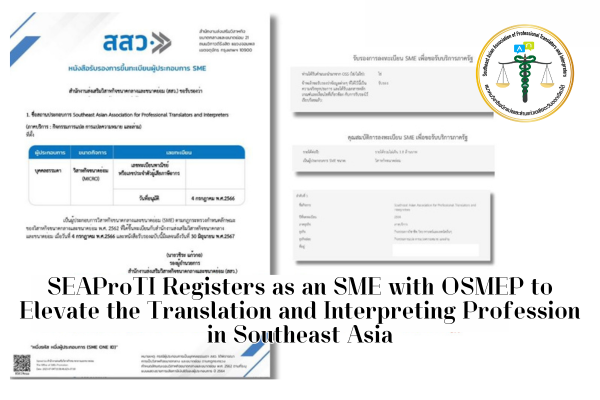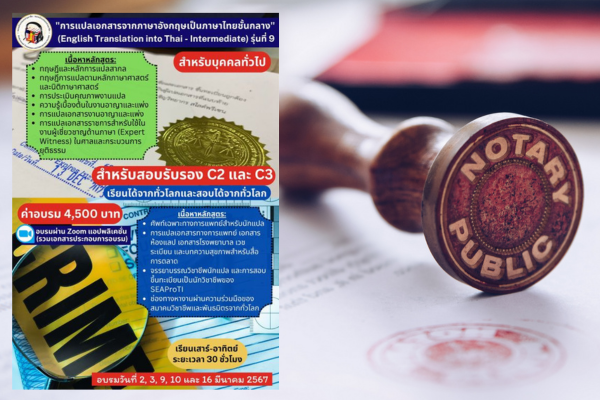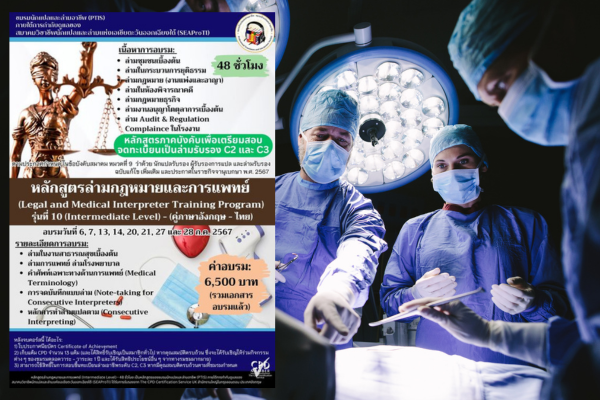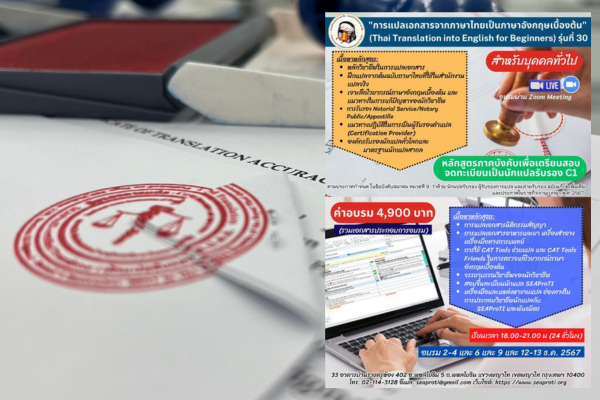Interpreter Rates for 2025: Importance and Guidelines for Fair Compensation
5 January 2025, Bangkok – In 2025, setting interpreter rates in the business sector is of great significance as the business world continues to change rapidly. With increasing cross-border connections and international business activities, the role of interpreters has become more vital. Interpreters are not just language mediators but also cultural bridges, fostering understanding and building strong relationships between business partners. This article provides an overview of the recommended interpreter rates for 2025 and explains the factors influencing these rates.
Interpreter Rates by Job Type
The recommended interpreter rates for 2025 are as follows:
| Job Type | Half Day (4 hours) | Full Day (8 hours) | Hourly Overtime |
|---|---|---|---|
| TH <-> EN (CI) | 3,500 | 6,000 | 500 |
| TH <-> 3L (CI) | 5,000 | 8,000 | 600 |
| TH <-> EN (SI) | 6,000 | 9,000 | 700 |
| TH <-> 3L (SI) | 10,000 | 15,000 | 1,200 |
Notes:
-
TH <-> EN refers to interpreting between Thai and English.
-
TH <-> 3L refers to interpreting between Thai and three other languages (Third Languages).
-
CI refers to Consecutive Interpreting.
-
SI refers to Simultaneous Interpreting.
Factors Influencing Interpreter Rates
Setting interpreter rates depends not only on job type and duration but also on several key factors:
-
Expertise in Specific Fields Interpreters working in specialized fields, such as law, medicine, or technology, require in-depth knowledge and expertise in those areas. This may result in a 10-15% increase over standard rates.
-
Location and Working Conditions If the job location is remote or if the interpreter must work during unconventional hours, such as late at night, rates may need to be adjusted to reflect the added difficulty and sacrifice.
-
Experience and Professional Certification Interpreters certified by reputable organizations, such as SEAProTI (Southeast Asian Association of Professional Translators and Interpreters), often command higher rates due to their credibility and proven skills.
-
Type of Interpretation Simultaneous Interpreting requires greater skill and concentration compared to Consecutive Interpreting, leading to higher rates.
-
Market Demand In some areas or industries with high demand for interpreters, rates may rise according to market forces.
The Importance of Fair Rates
Fair interpreter rates not only ensure that interpreters receive just compensation but also impact the quality of work and client satisfaction. Interpreters who are fairly compensated are more likely to prepare thoroughly and perform their duties with dedication. Additionally, adhering to standard rates helps prevent unfair competition in the labor market.
Considerations for Employers
Employers should consider the following factors when hiring interpreters:
-
Verify Interpreter Qualifications Check if the interpreter is professionally certified or has relevant experience in the required field.
-
Clearly Specify Requirements Provide detailed job requirements, such as topics, duration, and location, to help interpreters assess the suitability of the offered rates.
-
Avoid Inappropriate Bargaining Unreasonable negotiations may harm the relationship between the employer and interpreter and affect the quality of the delivered work.
Conclusion
In 2025, interpreter rates are set to align with changes in the labor market and increasing business demands. Fair rates not only ensure proper compensation for interpreters but also foster positive relationships between employers and interpreters, ultimately contributing to high-quality work and long-term business success. Employers and interpreters should collaborate to establish reasonable and mutually beneficial rate standards.
About SEAProTI’s certified translators, translation certification providers, and certified interpreters:
The Southeast Asian Association of Professional Translators and Interpreters (SEAProTI) has officially announced the criteria and qualifications for individuals to register as “Certified Translators,” “Translation Certification Providers,” and “Certified Interpreters” under the association’s regulations. These guidelines are detailed in Sections 9 and 10 of the Royal Thai Government Gazette, issued by the Secretariat of the Cabinet under the Office of the Prime Minister of the Kingdom of Thailand, dated July 25, 2024, Volume 141, Part 66 Ng, Page 100.
To read the full publication, visit: the Royal Thai Government Gazette
อัตราค่าจ้างล่ามในปี 2568: ความสำคัญและแนวทางการกำหนดค่าตอบแทนที่เหมาะสม
5 มกราคม 2568, กรุงเทพมหานคร – ในปี 2568 การกำหนดอัตราค่าจ้างล่ามในภาคธุรกิจมีความสำคัญอย่างยิ่ง เนื่องจากโลกธุรกิจในยุคปัจจุบันกำลังเปลี่ยนแปลงไปอย่างรวดเร็ว โดยการเชื่อมต่อระหว่างประเทศและการทำธุรกิจข้ามชาติเพิ่มมากขึ้นอย่างต่อเนื่อง ส่งผลให้บทบาทของล่ามมีความสำคัญมากขึ้น ไม่เพียงแต่เป็นตัวกลางในการแปลภาษา แต่ยังเป็นผู้สนับสนุนความเข้าใจทางวัฒนธรรมและการสร้างความสัมพันธ์ที่ดีระหว่างคู่ค้าทางธุรกิจ บทความนี้จะนำเสนอข้อมูลเกี่ยวกับอัตราค่าจ้างล่ามที่แนะนำในปี 2568 พร้อมทั้งอธิบายปัจจัยที่มีผลต่อการกำหนดอัตราดังกล่าว
อัตราค่าจ้างล่ามตามประเภทงาน
ในปี 2568 อัตราค่าจ้างล่ามที่ได้รับการแนะนำมีรายละเอียดดังนี้:
| ประเภทงาน | ครึ่งวัน (4 ชั่วโมง) | เต็มวัน (8 ชั่วโมง) | ส่วนเวลา/ชั่วโมง |
|---|---|---|---|
| TH <-> EN (CI) | 3,500 | 6,000 | 500 |
| TH <-> 3L (CI) | 5,000 | 8,000 | 600 |
| TH <-> EN (SI) | 6,000 | 9,000 | 700 |
| TH <-> 3L (SI) | 10,000 | 15,000 | 1,200 |
หมายเหตุ:
-
TH <-> EN หมายถึงการล่ามระหว่างภาษาไทยและภาษาอังกฤษ
-
TH <-> 3L หมายถึงการล่ามระหว่างภาษาไทยกับภาษาอื่น ๆ อีกสามภาษา (Third Languages)
-
CI หมายถึงการล่ามแบบต่อเนื่อง (Consecutive Interpreting)
-
SI หมายถึงการล่ามแบบทันที (Simultaneous Interpreting)
ปัจจัยที่มีผลต่อการกำหนดอัตราค่าจ้างล่าม
การกำหนดอัตราค่าจ้างล่ามไม่ได้ขึ้นอยู่กับประเภทงานและระยะเวลาเพียงอย่างเดียว แต่ยังมีปัจจัยอื่น ๆ ที่มีบทบาทสำคัญ ได้แก่:
-
ความเชี่ยวชาญในหัวข้อเฉพาะทาง ล่ามที่ต้องทำงานในหัวข้อเฉพาะทาง เช่น กฎหมาย การแพทย์ หรือเทคโนโลยี จำเป็นต้องมีความรู้และความเชี่ยวชาญในสาขานั้น ๆ ซึ่งอาจมีการเพิ่มค่าจ้าง 10-15% จากอัตรามาตรฐาน
-
สถานที่และเงื่อนไขการทำงาน หากสถานที่ทำงานอยู่ในพื้นที่ที่ยากต่อการเข้าถึง หรือในกรณีที่ล่ามต้องทำงานในเวลาที่ไม่ปกติ เช่น ช่วงดึก อัตราค่าจ้างอาจต้องมีการปรับเพิ่มเพื่อสะท้อนถึงความลำบากและความเสียสละของล่าม
-
ประสบการณ์และการรับรองวิชาชีพ ล่ามที่ได้รับการรับรองวิชาชีพจากองค์กรที่มีชื่อเสียง เช่น SEAProTI (Southeast Asian Association of Professional Translators and Interpreters) มักได้รับความไว้วางใจมากกว่าและสามารถกำหนดอัตราค่าจ้างที่สูงขึ้นได้
-
ประเภทของการล่าม การล่ามแบบทันที (Simultaneous Interpreting) ต้องใช้ทักษะและสมาธิสูงกว่าเมื่อเทียบกับการล่ามแบบต่อเนื่อง (Consecutive Interpreting) ส่งผลให้อัตราค่าจ้างสูงกว่า
-
ความต้องการของตลาด ในบางพื้นที่หรือบางอุตสาหกรรมที่มีความต้องการล่ามสูง อัตราค่าจ้างอาจเพิ่มขึ้นตามกลไกตลาด
ความสำคัญของอัตราค่าจ้างที่เหมาะสม
การกำหนดอัตราค่าจ้างที่เหมาะสมไม่เพียงช่วยให้ล่ามได้รับค่าตอบแทนที่เป็นธรรม แต่ยังส่งผลต่อคุณภาพของงานและความพึงพอใจของผู้ว่าจ้าง ล่ามที่ได้รับค่าตอบแทนที่เหมาะสมมีแนวโน้มที่จะเตรียมตัวและปฏิบัติงานด้วยความมุ่งมั่นและตั้งใจมากขึ้น นอกจากนี้ การใช้อัตราค่าจ้างมาตรฐานยังช่วยป้องกันการแข่งขันที่ไม่เป็นธรรมในตลาดแรงงานอีกด้วย
ข้อควรพิจารณาสำหรับผู้ว่าจ้าง
ผู้ว่าจ้างควรพิจารณาปัจจัยดังต่อไปนี้ในการว่าจ้างล่าม:
-
ตรวจสอบคุณสมบัติของล่าม ควรตรวจสอบว่าล่ามมีการรับรองวิชาชีพหรือมีประสบการณ์ในสาขาที่เกี่ยวข้องหรือไม่
-
ระบุความต้องการอย่างชัดเจน ผู้ว่าจ้างควรระบุรายละเอียดงาน เช่น หัวข้อ ระยะเวลา และสถานที่ทำงาน เพื่อช่วยให้ล่ามสามารถประเมินความเหมาะสมของอัตราค่าจ้างได้
-
หลีกเลี่ยงการต่อรองในลักษณะที่ไม่เหมาะสม การต่อรองที่ไม่เหมาะสมอาจส่งผลต่อความสัมพันธ์ระหว่างผู้ว่าจ้างและล่าม รวมถึงคุณภาพของงานที่ได้รับ
บทสรุป
ในปี 2568 อัตราค่าจ้างล่ามได้รับการกำหนดให้สอดคล้องกับความเปลี่ยนแปลงในตลาดแรงงานและความต้องการของธุรกิจที่เพิ่มขึ้น การกำหนดอัตราที่เหมาะสมไม่เพียงแต่ช่วยให้ล่ามได้รับค่าตอบแทนที่เป็นธรรม แต่ยังส่งเสริมความสัมพันธ์ที่ดีระหว่างผู้ว่าจ้างและล่าม ซึ่งมีผลต่อคุณภาพงานและความสำเร็จของธุรกิจในระยะยาว ผู้ว่าจ้างและล่ามจึงควรร่วมมือกันในการสร้างมาตรฐานอัตราค่าจ้างที่สมเหตุสมผลและเป็นประโยชน์ต่อทุกฝ่าย
เกี่ยวกับนักแปลรับรอง ผู้รับรองการแปล และล่ามรับรองของสมาคมวิชาชีพนักแปลและล่ามแห่งเอเชียตะวันออกเฉียงใต้
สมาคมวิชาชีพนักแปลและล่ามแห่งเอเชียตะวันออกเฉียงใต้ (SEAProTI) ได้ประกาศหลักเกณฑ์และคุณสมบัติผู้ที่ขึ้นทะเบียนเป็น “นักแปลรับรอง (Certified Translators) และผู้รับรองการแปล (Translation Certification Providers) และล่ามรับรอง (Certified Interpreters)” ของสมาคม หมวดที่ 9 และหมวดที่ 10 ในราชกิจจานุเบกษา ของสำนักเลขาธิการคณะรัฐมนตรี ในสำนักนายกรัฐมนตรี แห่งราชอาณาจักรไทย ลงวันที่ 25 ก.ค. 2567 เล่มที่ 141 ตอนที่ 66 ง หน้า 100 อ่านฉบับเต็มได้ที่: นักแปลรับรอง ผู้รับรองการแปล และล่ามรับรอง

